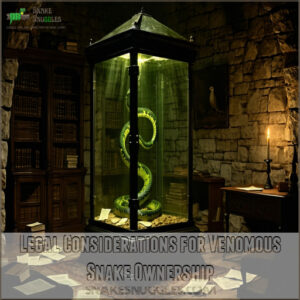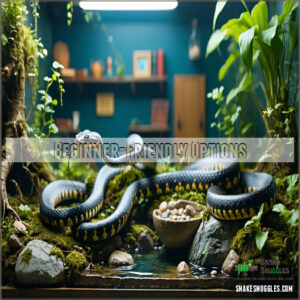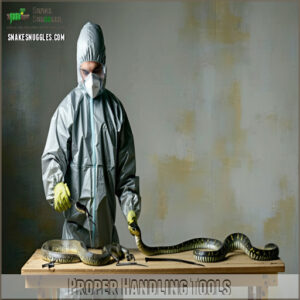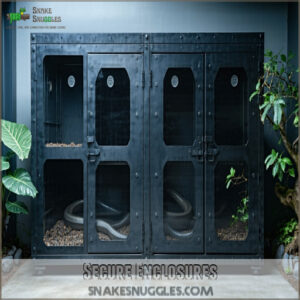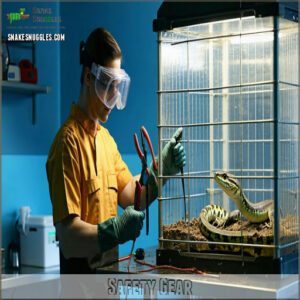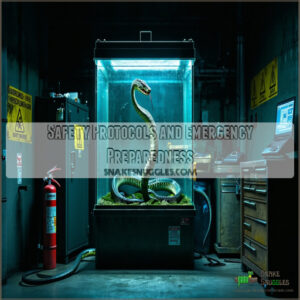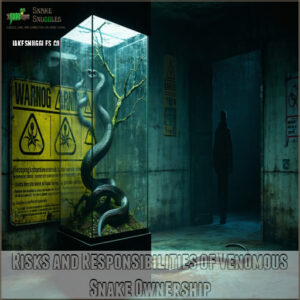This site is supported by our readers. We may earn a commission, at no cost to you, if you purchase through links.
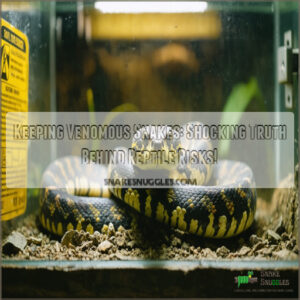
You’ll need more than guts—you’ll need rock-solid legal knowledge, specialized training, and nerves of steel.
Local laws vary dramatically, so check your city and state regulations first. You’ll likely need special permits and a certified mentor with serious handling experience.
Native species are your safest bet, offering predictable behavior and available antivenom. Invest in high-quality safety gear, secure enclosures, and learn precise handling techniques.
One wrong move could turn your reptile passion into a life-threatening dance. Curious about exploring this high-stakes world of venomous snake ownership?
Table Of Contents
- Key Takeaways
- Legal Considerations for Venomous Snake Ownership
- Choosing The Right Venomous Snake Species
- Essential Equipment for Venomous Snake Keeping
- Safety Protocols and Emergency Preparedness
- Risks and Responsibilities of Venomous Snake Ownership
- Frequently Asked Questions (FAQs)
- Can you keep venomous snakes?
- How to stay safe from venomous snakes in your backyard?
- What should I do if a snake eats my house?
- How do you keep a snake from shedding?
- How Often Should Venomous Snakes Be Fed?
- What Are the Consequences of Illegal Trading of Venomous Snakes?
- Are Venomous Snakes Legal to Keep in All States?
- What is the Best Way to Transport a Venomous Snake?
- Are There Any Venomous Snake Species That Are Easier to Care For?
- Is it legal to have a venomous snake as a pet?
- Conclusion
Key Takeaways
- You’ll need to navigate a complex legal landscape before keeping venomous snakes, with permits, state regulations, and local ordinances varying dramatically across different jurisdictions.
- Your safety depends on investing in high-quality specialized equipment like secure enclosures, professional handling tools, and protective gear that can prevent potentially fatal interactions.
- Finding an experienced mentor is crucial—they’ll be your lifeline in learning precise handling techniques, understanding snake behavior, and developing the skills needed to manage these dangerous reptiles safely.
- Keeping venomous snakes isn’t just a hobby, it’s an extreme responsibility that demands unwavering expertise, constant vigilance, and a commitment to both animal welfare and community safety.
Legal Considerations for Venomous Snake Ownership
Before you jump into venomous snake ownership, you’ll need to navigate a complex legal landscape that varies wildly from state to state.
Understanding your local regulations, securing the right permits, and finding an experienced mentor aren’t just recommended—they’re absolutely critical to keeping both you and your scaly companion safe and legal.
State and Local Laws
Before diving into the venomous snake world, you’ll need to navigate a complex maze of state and local regulations.
Each jurisdiction has its own rulebook for snake ownership, with laws that can change faster than a snake sheds its skin.
Check local ordinances carefully, as city rules might be stricter than state laws, and some areas require special licenses, while others mandate mentorship or inspections.
Zoning restrictions and Regulatory Compliance can make or break your snake-keeping dreams, so do your homework, and your local wildlife agency holds the key to understanding these intricate snake laws.
Understanding venomous snake ownership is essential for compliance with these regulations.
Permit Requirements
After traversing state laws, you’ll hit your next hurdle: snake permits. Each state carves out unique permit categories based on venom toxicity – from mildly dangerous Category 1 to spine-chilling Category 3 snakes.
Your application journey involves property inspections, local authority approvals, and proving you’ve sourced snakes from legal permit holders. Processing times range from a lightning-quick 5 days to a nerve-wracking 2 weeks.
Understanding venomous snake permits is vital for a successful application.
- Pro tip: Research your state’s specific snake permit requirements before investing time and money in your venomous reptile adventure.
Different regions play by different rules, so know your local landscape before bringing home a potentially deadly pet.
Finding a Mentor
Seeking a snake mentor? Buckle up for the most critical partnership in your venomous reptile journey. Finding the right guide can mean the difference between success and disaster.
The ideal mentor should possess certain qualities, which are outlined in the following table:
| Mentor Qualities | Snake Experience | Communication |
|---|---|---|
| Certified | 5+ Years Handling | Clear Instructions |
| Knowledgeable | Multiple Species | Responsive |
| Safety-Focused | Veterinary Contacts | Patient |
| Emergency Trained | Antivenom Protocols | Supportive |
To find a suitable mentor, tap into herpetological societies, online forums, and Facebook groups to connect with seasoned experts. A highly skilled mentor brings decades of hands-on experience, offering invaluable insights into species-specific care, handling techniques, and local regulations.
They’re your lifeline in this high-stakes hobby, transforming potential risks into calculated, controlled interactions with venomous serpents.
Choosing The Right Venomous Snake Species
If you’re dreaming of keeping a venomous snake, you’ll need to choose your species with the precision of a surgeon and the caution of a tightrope walker.
Your success hinges on understanding each species’ unique temperament, venom potency, and the critical availability of local antivenom—so research thoroughly before bringing home your scaled, potentially deadly companion.
Native Vs. Exotic Species
After cracking the legal code, you’re ready to choose your venomous companion.
Not all snakes are created equal, and your choice can mean life or death.
- Native species offer predictable behavior
- Local antivenoms are readily available
- Exotic snakes demand intensive research
- Hospital preparedness varies dramatically
Native venomous snakes come with a home-field advantage. They’re adapted to local ecosystems, and medical professionals typically know their venom profiles.
Exotic species? They’re wild cards. Each brings unique challenges: unpredictable toxins, specialized care needs, and potential treatment complications.
Your safety hinges on understanding these critical differences.
Beginner-Friendly Options
After nailing down native snake species, it’s time to pick your first venomous reptile companion.
As a beginner in snake breeding, you’ll want to start with species that won’t make you jump out of your skin.
Copperheads and coral snakes top the list for pet safety, offering milder temperaments and less aggressive venom.
Think of them as the training wheels of the venomous snake world.
Local species have a bonus: nearby hospitals are more likely to stock the right antivenom.
Pro tip for reptile care: research is your best friend.
Don’t just pick a snake that looks cool – choose one that matches your experience level and won’t turn your first venomous snake adventure into a nightmare.
Understanding Snake Characteristics
After picking a beginner-friendly venomous snake, you’ll want to become a snake detective.
Understanding Snake Behavior and venom types isn’t just cool—it’s survival 101.
Learn to spot unique Scale Patterns and Heat Sensing capabilities that make each species a living, breathing marvel.
Explore how their Hunting Modes reveal their temperament.
Decode their venom’s potency and biological makeup to prep for potential emergencies.
Study their natural habitat like you’re mapping their ancestral home.
By mastering these snake characteristics, you’ll transform from a nervous novice to a confident handler who respects these incredible reptiles’ complex world.
Considering the importance of snake care requirements is vital for a successful and safe experience with venomous snakes.
Essential Equipment for Venomous Snake Keeping
If you’re serious about keeping venomous snakes, you’ll need more than just guts and good intentions.
Your survival depends on investing in rock-solid equipment that’ll keep both you and your slithery companion safe from potential disaster.
This investment is crucial for preventing accidents and ensuring the well-being of both the snake and the handler, which is why having the right equipment is vital.
Proper Handling Tools
After choosing your venomous snake, mastering handling tools becomes your lifeline.
Professional snake hooks, precision tongs, and heavy-duty restraints aren’t just accessories—they’re your first line of defense.
Whether you’re a rookie or seasoned handler, investing in quality snake handling equipment means the difference between a safe encounter and a dangerous mistake.
Learn proper techniques, match tools to your specific snake species, and always prioritize safety with every careful movement.
Handling venomous snakes requires understanding proper snake hook techniques and snake handling tools, which is crucial for a successful handling experience.
Secure Enclosures
After mastering handling tools, your next defense against disaster is a rock-solid enclosure.
Think of it as a fortress for your venomous resident.
Your snake’s home needs military-grade locking mechanisms and escape-proofing that’d make a maximum-security prison look amateur.
Proper ventilation systems and precise temperature control aren’t just nice-to-haves—they’re survival requirements.
One tiny gap could turn your snake room into a neighborhood nightmare.
Design your snake enclosure with paranoid precision: reinforced walls, secure latches, and zero compromise on safety.
Your scaly companion’s world needs to be tighter than Fort Knox.
When building or purchasing, consider the importance of proper snake enclosures with secure snake habitats to guarantee the well-being of your pet.
Safety Gear
Your last line of defense against venomous snake bites isn’t luck—it’s top-tier safety gear.
When handling these potentially lethal reptiles, you’ll need essential protection to stay safe and confident.
Here’s your critical snake safety toolkit:
- Snake hooks for precision distance control
- Cut-resistant gloves blocking potential strikes
- Impact-resistant goggles shielding vulnerable eyes
- Reinforced handling tongs ensuring maximum control
Proper use of snake handling equipment requires understanding snake hook techniques to minimize risks.
Safety Protocols and Emergency Preparedness
When you’re dealing with venomous snakes, your life depends on knowing exactly what to do before disaster strikes.
You’ll need rock-solid safety protocols and lightning-fast emergency response skills that could mean the difference between life and death when handling these potentially deadly reptiles.
Handling Techniques
Anyone who wants to keep venomous snakes must become a safety ninja.
Your venomous snake handling protocol demands razor-sharp focus and zero-tolerance for mistakes.
Use specialized hook safety techniques, wear thick protective gloves, and master snake wrapping with professional-grade tongs.
Keep calm, move deliberately, and always have a trained partner nearby to prevent potential escape scenarios, ensuring a zero-tolerance approach to mistakes.
Antivenom Availability
Your lifeline in a venomous snake emergency hinges on three critical antivenom protocols.
Knowing local hospitals’ snake antivenom inventory can mean the difference between life and death.
Medical response requires precise preparation and swift action.
- Connect with regional poison control centers to map out emergency venom research networks and local antivenom resources.
Anticipate potential challenges: some antivenoms cost thousands, and availability varies dramatically by region and snake species, which is a critical aspect of snake antivenom inventory.
Escape Prevention
Battling potential escapes demands vigilance when housing venomous serpents.
Design your snake enclosures with solid locks, reinforced edges, and escape-proof barriers. Install secure lids with precision-engineered ventilation that prevents even the craftiest reptile from slipping out.
Keep an emergency capture kit nearby, and regularly inspect your snake’s home for any weak spots or damage that could compromise containment.
Ensuring a secure environment requires attention to escape proof designs that prioritize the snake’s safety and well-being.
Risks and Responsibilities of Venomous Snake Ownership
If you’re considering venomous snake ownership, you’re stepping into a world of serious responsibility that demands unwavering expertise and commitment.
Think twice before bringing these potentially deadly reptiles into your home, as one wrong move could mean the difference between life and death for you, your loved ones, and anyone who comes near your scaly companion, which is a matter of serious responsibility.
Potential Dangers
If something could go wrong with venomous snake ownership, it probably will.
Your journey into this high-stakes hobby comes with life-altering risks that demand serious respect.
- Bite Risks: One wrong move means potential fatal envenomation requiring immediate medical intervention
- Psychological Strain: Constant vigilance creates intense mental pressure and stress responses
- Financial Devastation: Medical treatments, liability insurance, and potential legal complications can drain your resources
Every interaction becomes a calculated dance with danger.
Ethical Considerations
When you’re juggling the weighty responsibility of venomous snake ownership, moral obligations stretch far beyond your personal fascination.
Your choices ripple through animal welfare, conservation efforts, and public safety.
Responsible keeping means respecting the snake’s natural behaviors, understanding its intrinsic rights, and proactively managing potential risks to your community and the species itself.
This includes adopting proper snake handling techniques to guarantee a safe environment for both humans and animals, which is a key part of responsible keeping and ensures public safety.
Community Impact
Your venomous snake hobby isn’t just a personal passion—it’s a community responsibility.
Neighbors might feel uneasy, so proactively address their concerns through transparent communication.
Build trust by demonstrating your thorough safety protocols and deep respect for herpetoculture.
Remember, your actions shape public perception of responsible keeping.
One misstep can trigger local regulatory scrutiny and amplify social stigma around snake enthusiasts.
Stay informed, stay accountable, protect both your reptiles and community.
Frequently Asked Questions (FAQs)
Can you keep venomous snakes?
Between thrill and terror, you’ll need special permits, professional expertise, and strict safety protocols to legally keep venomous snakes . It’s not for the faint-hearted – expect rigorous regulations and life-threatening risks.
How to stay safe from venomous snakes in your backyard?
Keep your yard clean and tidy, mowing grass short and removing debris.
Seal entry points, eliminate rodent hiding spots, and stay alert to spot potential snake threats before they become dangerous.
What should I do if a snake eats my house?
Like a snake slithering through your nightmares, if a snake eats your house, don’t panic.
Call wildlife experts immediately.
They’ll safely remove the snake and assess any structural damage, preventing further property destruction.
How do you keep a snake from shedding?
Provide a humid environment with a moisture hide box to support healthy shedding.
Mist your snake’s enclosure and guarantee proper temperature gradients to help them smoothly remove their old skin without complications.
How Often Should Venomous Snakes Be Fed?
Depending on their species, you’ll feed venomous snakes every 1-4 weeks.
Younger snakes need more frequent meals, while adults can wait longer between feedings, matching their natural metabolic rhythms in the wild.
What Are the Consequences of Illegal Trading of Venomous Snakes?
You’re playing with fire when you enter the illegal venomous snake trade: hefty fines, potential prison time, and severe ecological disruption threaten both your freedom and global wildlife populations.
Are Venomous Snakes Legal to Keep in All States?
You won’t find uniform snake laws across states. Twenty states require permits, while Alaska, California, and Hawaii ban them completely. Your local laws determine what’s possible.
What is the Best Way to Transport a Venomous Snake?
Like dancing with lightning in your hands, transport venomous snakes in a secure, lockable container with air holes.
Always use snake hooks and wear protective gear like gloves, boots, and goggles.
Are There Any Venomous Snake Species That Are Easier to Care For?
Some venomous snakes, like copperheads and certain rattlesnake species, are relatively docile and easier to manage.
However, they still demand expert handling, specialized enclosures, and advanced reptile experience to guarantee your safety and their well-being.
Is it legal to have a venomous snake as a pet?
Did you know that only 20 states permit venomous snake ownership with a permit.
You’ll need to navigate a maze of complex regulations.
Check your local laws carefully before bringing home a potentially deadly pet – your safety and legal standing depend on it.
Conclusion
Ultimately, keeping venomous snakes isn’t just a hobby—it’s a life-altering commitment that demands absolute respect and preparation.
You’ll need unwavering dedication, professional-grade safety protocols, and a deep understanding of these incredible reptiles.
Whether you’re a seasoned herpetologist or an ambitious enthusiast, the journey of keeping venomous snakes requires more than passion—it demands precision, patience, and profound responsibility.
Your success hinges on continuous learning, rigorous safety practices, and an unshakeable commitment to both snake and human welfare.
- https://www.reddit.com/r/snakes/comments/15jizvq/in_your_opinion_what_are_the_most_reasonable_pet/
- https://findyourreptile.com/reptile-info/venomous-articles/introduction-keeping-venomous-snakes-captivity/
- https://www.facebook.com/southernexoctics/photos
- http://www.adfg.alaska.gov/index.cfm?adfg=pets.exotic
- https://www.dfw.state.or.us/OARs/56.pdf

